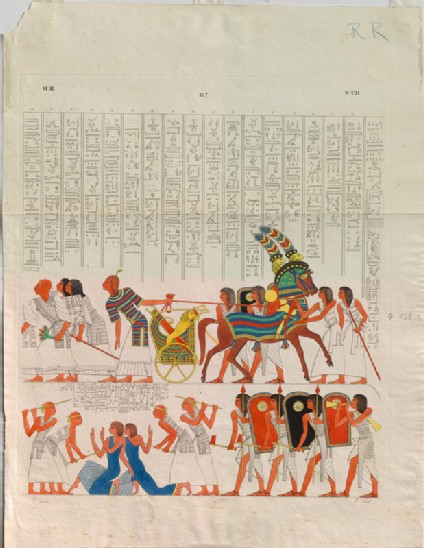Browse: 1470 objects
Engraving of a Relief of the Chariot of Ramesses II from the Depiction of the Battle of Qadesh in the Great Hall of the Temple at Abu Simbel Anonymous Italian
-
Curator’s description:
Description
The scene is arranged in two registers. On the top are a series of figures facing to the left and, in the middle, a chariot drawn by two horses, facing to the right. The figure holding the horses' reins stands behind the chariot, and faces left; both he and the horses wear striped coats. The spaces above the figures' heads are filled with hieroglyphs. On the bottom, on the left, two pairs of shaven-headed men appear to be beating two Hittite spies, dressed in blue, with staffs; on the right is a line of three soldiers (the pharaoh's foreign Shardana bodyguard), armed with spears, hatchets, and long shields, wearing their hair long, and a trumpeter. The relief is part of the vast depiction of the Battle of Qadesh which occupies an entire wall of the Great Hall of the Temple at Abu Simbel (Porter & Moss, "Topographical Bibliography", 2nd ed, Oxford (Clarendon Press & Griffith Institute): 1960-1999, vol. VII, pp. 103-104).
The print is taken from the first volume of plates from Ippolito Rosellini's "Monumenti dell' Egitto e della Nubia", published in 1832. It was first catalogued by Ruskin in the "Catalogue of Examples" of 1870, as no. 102 in the Standard Series, called "Chariot of Rameses III"; in the 1872 catalogue of the Standard and Reference Series, it was renumbered as no. 176 in the Reference Series. It was placed alongside other plates from Rosellini, including one depicting the entire image, of which this is but a detail, at no. 178. Cook and Wedderburn's identification of this item in the catalogues as Rosellini's vol. III, Tavole, pl. LXXXIV (XXI.44 n. 4) is clearly erroneous, and Ruskin himself makes it clear that this is one of the details which immediately followed Reference Series no. 178 in Rosellini's book.
Neither the draughtsman, named as 'C', nor the engraver, named as 'M', can be identified with certainty.
In a note in "The Ethics of the Dust", explaining how the individual aspects of the Egyptian deities were still largely unknown, Ruskin was somewhat sceptical of Rosellini's qualities: 'for the full titles and utterances of the gods, Rosellini is as yet the only - and I believe, still a very questionable - authority' (Ethics of the Dust, note III = XVIII.363). In his entry below nos 176-180 in the Reference Series, Ruskin again questioned Rosellini's accuracy, noting that the colours were sometimes conjectural, 'slight traces of the original pigments, and those changed by time, being interpreted often too arbitrarily' (Standard and Reference Series catalogue, p. 22).
In the section of "Aratra Pentelici" which expanded upon his lecture on "Imagination" of 26 November 1870, Ruskin was more interested in the relationship between sculpture and polychromy, noting that 'all the early sculpture of the most accomplished nations has been thus coloured' and that, as soon as colour was applied within a scratched outline, 'the colouring soon becomes a principal means of effect, so that, in the engraving of an Egyptian-colour bas-relief (S. 101 [now Reference Series no. 176]), Rosellini has been content to miss the outlining incisions altogether, and represent it as a painting only' (Aratra Pentelici, § 32 = XX.222)
-
Details
- Artist/maker
-
Anonymous Italian (Anonymous, Italian) (artist, engraver)
- Object type
- Material and technique
- watercolour and bodycolour over engraving on wove paper
- Dimensions
- 464 x 438 mm (stone); 661 x 514 mm (sheet)
- Associated place
-
- The Ancient Egyptian World › Nubia › Abu Simbel › The Great Temple › The Great Temple (subject)
- Inscription
- Recto, engraved:
top left: M.R.
top centre: B.7.
top right: No. CII.
the columns of hieroglyphs in the background are labelled with a number above each column, reading, right to left, '1' to '18'
just below the image, left: C.
just below the image, right: M. Scul.
Recto, manuscript:
top right, in blue pencil: RR
right, just below centre, in graphite: 4.135.2
Verso, all in graphite:
lower left edge, written down the sheet: 4.135.2
bottom edge, right of centre: 4.224.8.33.201.219.251
bottom centre, the Ruskin School's stamp
On a separate small paper label, in graphite: was 102 G A
- Provenance
-
Presented by John Ruskin to the Ruskin Drawing School (University of Oxford), 1875; transferred from the Ruskin Drawing School to the Ashmolean Museum, c.1949.
- No. of items
- 1
- Accession no.
- WA.RS.REF.177
-
Subject terms allocated by curators:
Subjects
-
References in which this object is cited include:
References
Ruskin, John, Catalogue of Examples Arranged for Elementary Study in the University Galleries (Oxford: Clarendon Press, 1870), cat. Standard no. 102
Rosellini, Ippolito, I monumenti dell' Egitto e della Nubia: Disegnati dalla spedizione scientifico-letteraria toscana in Egitto: distributi in ordine di materie, 12 (Pisa: Presso N. Capurro, 1832-1844), pt I, Tavole, pl. CII
Ruskin, John, Catalogue of the Reference Series Including Temporarily the First Section of the Standard Series (London: Smith, Elder, [1872]), cat. Reference no. 177
Ruskin, John, ‘The Ruskin Art Collection at Oxford: Catalogues, Notes and Instructions’, Edward T. Cook and Alexander Wedderburn, eds, The Works of John Ruskin: Library Edition, 39 (London: George Allen, 1903-1912), 21, cat. Reference no. 177
Location
-
- Western Art Print Room





